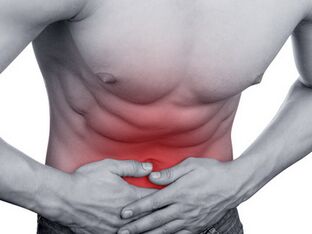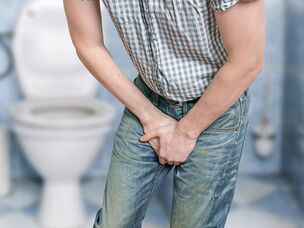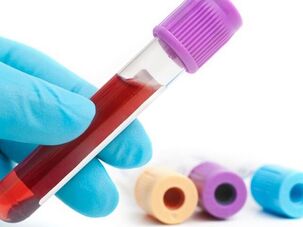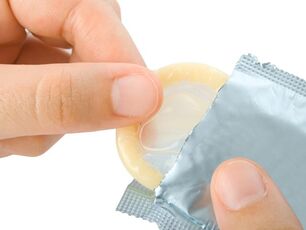Prostatitis refers to a purely male pathology of the urinary and reproductive system. The disease can be acute or chronic, which manifests itself differently in each patient. Today, it is a common disease of the genitourinary system. Currently, the disease is much younger and already occurs in men older than 25 years. In this article, we will consider the question: how does prostatitis manifest and how is it treated.

Required information
The nature of prostate dysfunction depends on a certain stage of sexual development in men:
- Prostate damage is possible in underage men. However, such a disease is not considered a separate disease due to an underdeveloped gland;
- men who have a violent sex life are more likely to undergo prostatitis in the form of an acute inflammatory process;
- prostate disease in adult men manifests itself in the form of one of three diseases: benign and malignant tumors, chronic prostatitis.
People who undergo any type of reproductive organ removal do not have prostate function.
The prostate is an auxiliary gland of the reproductive apparatus in the strong half. It is located at the junction of the urinary tract and the ejaculatory tunnel. The importance of the prostate in adolescent men before puberty has been challenged by research. The prostate in an adult is responsible for:
- creating a secretion that makes the seminal fluid less viscous and allows the sperm to survive on its way to the egg;
- production of prostaglandins in the body. It is the component that is responsible for the increased blood flow in the genitals before creating an erection. It also promotes the production of the hormone testosterone;
- is responsible for the high rate of semen release during ejaculation, and also participates in the appearance of the last moment of sexual intercourse associated with the peak of intimate pleasure;
- with the help of reflexes does not allow the penetration of urine into the seminal fluid during intimate relations.
The prostate is a poorly protected organ for pathogenic microbes. It directly depends on the pathological conditions of the pelvic organs. The large flow of blood and lymph that moves through the vessels of the damaged prostate leads to the phenomenon of stagnation and edema, thus worsening the inflammation. The gland contains a large number of nerve fibers, so the pathology is manifested by pain.

Prostatitis is an inflammatory damage to the prostate. The most common cause of this disease are pelvic infections. But an infected infection alone is not capable of causing inflammation; this requires the presence of predisposing factors. This category includes:
- measured lifestyle (people with inactive work are at risk);
- regular stool retention;
- numerous hypothermia;
- excessively active intimacy and long periods of abstinence;
The prostate is a small organ and weighs approximately 20-25 grams. But the secretion gland has the ability to have a destructive effect on microbes, so inflammation in the prostate occurs during stagnation, and then the secretion loses its bactericidal property.
Manifestations of prostatitis
There are two stages of the disease:
The acute form is manifested by the strongest inflammation in the prostate. The patient has a temperature of up to 39 degrees, the pain is in the groin area and in the process of excreting feces and urine through the body. These are the first characteristic symptoms of prostatitis.
In the chronic course, these symptoms flatten out, so many men do not pay attention to the characteristic manifestations of the disease. The patient may have a rise in temperature of up to 37 degrees, painful sensations during deurination and defecation. However, the main symptom of chronic prostatitis is the discharge of a small amount of mucous or purulent contents from the urethra.
Predisposing factors
There are the first 6 symptoms of prostatitis - this is a failure in the process of deurination due to the complex excretion of urine from the bladder when the urethra is compressed by an enlarged prostate (dysuria syndrome):
- urine drop by drop;
- painful sensations;
- stream of urine without pressure and not more than 20 cm;
- jet discontinuity;
- frequent deurination at night;
- feeling of incomplete bladder emptying.
Important! It is forbidden to diagnose prostatitis when these symptoms are detected without a thorough examination. This disease has a very complex process of origin and development, which involves various mechanisms.
Do not treat a disease based only on clinical manifestations. You must contact a specialist immediately for an accurate diagnosis and prescribing therapeutic measures. Diagnosis and therapy are prescribed taking into account the organs and systems affected by the disease. In some cases, you need to consult other experts.
Signs of disease
Prostatitis can manifest as an acute and chronic form of the inflammatory process. The acute course is characterized by inflammation of the mucosa, follicles, and parenchyma, but they should not be confused with the symptoms of prostate adenoma. And chronic - it is manifested by accompanying problems.
Symptoms of prostatitis in men, recognized by clinical and functional examinations:
- Frequent urination
A normal man may need deurin up to 12 times a day, usually 5 times. The amount of urine in a healthy patient is 1 to 2 liters per day. Desires for deurination in a healthy man occur when the bladder is filled with a volume of 120-170 ml. Accumulation of urine exceeding 350 ml creates the strongest urge to urinate.

In the inflammatory process, the bladder walls are systematically irritated and deurination becomes:
- is not uncommon, as the amount of urine is within normal limits;
- in small quantities: the products of the inflammatory process irritate the receptors of the bladder, and there are false desires for deurination, the feeling of a full bladder, after its emptying there is a feeling of its fullness;
- painful due to narrowing of the urethra;
- difficult due to compression of the urethra by the gland, which is sometimes manifested by the inability to empty the bladder when it is overcrowded;
- often at night;
- temperature.
Typically, the temperature rises from 37 to 38 degrees. In the initial stage of sepsis with purulent inflammation of the gland, the temperature rises over 39 degrees. In the last phase of septic shock, the temperature, on the contrary, drops to 35 degrees. Low temperature poses a threat to human life due to platelet clotting disorders. The outcome of prostatitis with complications of sepsis is unfavorable.
- Blood in urine
This is quite rare, but is a dangerous sign of the course of the disease. Constant bleeding is almost impossible to stop. There are several reasons for the development of hematuria:
- with perforation of the vessel in the urethra;
- trauma during research;
- malignant hyperplasia;
- pain.
Inflammation of the prostate with its complication is accompanied by constant pain. It can rarely be intermittent. The pains are most often dull or painful in nature and manifest in the perineum and anus.
Laboratory methods
Named to clarify the stage of the disease:
- Blood test. In the prostate, an increased content of leukocytes, an increase in the rate of erythrocyte sedimentation and a shift in the formula of leukocytes towards the stinging cells are detected;
- Urine analysis. It determines the purulent content in the urine and the presence of bacteria. A study of 3 jars is used: 3 portions of urine are taken at the beginning, in the middle and at the end of the deurination. Numerous urine studies in a few-day interval reveal a change in the bacterial flora;
- Bacteriological blood culture. It is prescribed for the development of blood poisoning with a daily temperature fluctuation of 3-5 degrees.

Instrumental Research
- Ultrasound through the rectum. To clarify the diagnosis is the most informative method. This study has contraindications.
- X-ray method. Before the examination, a contrast agent is injected into the bladder.
- Microscopic examination of a portion of the tissue is used for limited indications.
Causes of prostatitis
Experts identify several classifications of why a man can have prostatitis:
- complication of symptoms of any disease that has previously affected a person or the negative effect of gynecological problems in a partner;
- urethral reflex. Prostate failure is permeated by the inability to stop the return flow of urine. When this fluid enters the genital tract, it is called the urethral reflex. Bacterial seeding of the gland then occurs. Such a disease is the result of inflammatory processes in the urethra or improper insertion of a catheter. There is also dilation of the lumen of the urethral canal;
- an unusual way of intimate life. If a man has a significant increase or decrease in the number of sexual relations, it can contribute to the development of prostatitis. Constant delays in ejaculation are also a cause for concern;
- plug of venous blood in the genitals in the pelvic area. This happens in the absence of a sufficient number of active movements, sports;
- hormonal disorders caused by low production of hormones produced in the gonads. Due to this pathology there is a general weakness of skeletal and smooth muscles and other ailments.

Types of prostatitis
There are two divisions of this disease: bacterial and nonbacterial.
The first type is characterized by the fact that the disease occurs due to the presence of pathogenic microbes that have entered the body from the external environment. Staphylococci, streptococci, Escherichia coli and many others belong to the category of harmful microorganisms. In addition, this classification of prostatitis includes cases when the disease is caused by a previous disease that is transmitted through sexual contact.
For the second, non-bacterial species, there are several divisions:
- Congestive prostatitis. In this case, the gland disease occurs due to congestion in the pelvic area. This outcome usually leads to incomplete ejaculation, too many intimate acts, long abstinence, incomplete sexual intercourse.
- Sclerotic prostatitis. It is characterized by a decrease in prostate size and function. There is a thickening of the tissue membrane due to the death of prostate cells and their degeneration into hard connective tissue. The reasons for this type are frequent defecation disorders in the form of aggravated, slowed bowel function, taking certain medications and numerous infections. This type of prostate inflammation is incurable. Calculus prostatitis. In this type of inflammation, the presence of stones in the gland is detected. Reaching large size, they cause severe pain in the urethra. Therapy consists of removing stones by surgical or therapeutic methods.
- Prostatodynia. It is characterized by the presence of constant pain in the pelvic area, the causes of which have not been studied. It can probably be caused by the secretion of secretions, bladder neck disease, damage to the muscle tissue between the anus and genitals, and a psychological factor is possible.
- Atypical prostatitis. The patient may complain of pain in the lower extremities, lumbar and sacrum, which is not present in typical forms of prostatitis. The outcome of therapy is directly related to the duration of the course of the disease, the presence of complications and the severity of the inflammatory process.

If treatment is started at the wrong time or the prostatitis worsens repeatedly, the inflammation becomes serious, which is fraught with serious complications: reduced potency, inability to conceive, depressive states, severe pain, prostate adenoma in men.
Complications
It will all depend directly on age, immunity, bad habits and timeliness of treatment. Thus, in the elderly with a reduced immune system, complicated by excessive consumption of products containing alcohol, the consequences will be very severe.
Action on potency. A damaged gland reduces the production of hormones that are responsible for starting an erection. Complications include lack of fullness of sensation during intimacy, poor ejaculation, signs of prostate adenoma in men, and impotence.
Influence on conception of a child. Inflammation of the prostate greatly reduces the production of normal secretions needed for sperm activity in the female reproductive organs for fertilization. The secretion, which intimately enters the girl's birth canal, is exposed to immune rejection, which leads to the impossibility of fertilizing the egg.
Other complications. Exacerbation of prostatitis increases the risk of accumulation of pus in the glandular tissues. The pain of prostatitis increases. When the secondary infection is connected, the epithelium melts, followed by the appearance of a capsule near the inflammation. Also, the consequences include an acute form of urinary retention, urolithiasis, the appearance of prostate adenoma in men and others.
Intimacy with inflammation
It has already been proven that the main causes of prostatitis are lack of sexual intercourse with increased excitability or excessive sexual activity. Regular ejaculation with a normal frequency has a beneficial effect in the early stages of prostatitis. In some procedures and stages of the disease, intimacy is temporarily forbidden. More detailed information can be found in agreement with the specialist.
Important! You can make love during the treatment of prostatitis, but only with respect for safety and moderation in the relationship, unless your doctor determines otherwise.
Prostatitis is a purely male disease. But inflammation of the gland poses a health risk to the partner. It poses a danger to conceiving and giving birth to an unborn child. A healthy lifestyle and reliable contraception are an effective way to protect your partner from complications.

Treatment of prostatitis
It is possible to fully recover and stop the further development of the disease only by timely referral to a specialist. In this case, you will achieve a positive result. When irreversible changes occur, it is not possible to completely get rid of the disease. As a rule, recurrent inflammation occurs with the transition to the chronic type.
In addition to drug treatment, the important thing is whether the patient is willing to change their lifestyle (for example, irregular intimate relationships or a sedentary lifestyle). If the patient does not want to change his usual way of life, soon the disease will be felt again. Precisely with the fact that the patient does not want to change these negative factors, and the concept that prostatitis cannot be treated is connected.
Treatment options, the time period is prescribed by an expert after a complete examination and determination of the cause. Antibiotics are the main drug used during treatment. Vitamins, physiotherapy, analgesics and anti-inflammatory drugs are also recommended. Worsening of prostatitis lasts for a longer period of treatment.
Diet
With proper nutrition and the use of certain foods, you can achieve:
- reduce pain;
- improving blood and lymph movements in prostate vessels;
- strengthening the immune system;
- normalization of bowel function;
- decrease in urine production at night.
The following foods should be excluded from the diet:
- Coffee and spicy foods - increase blood flow to the prostate, increase pain.
- Fats, fatty meats, eggs, flour products - increase the formation of cholesterol plaques on the walls of blood vessels, reduce blood flow.
- Alcoholic products - lower the body's immune system.
- Foods with coarse fiber and salty - violates the wavy contractions of the intestinal walls.
- Excessive fluid intake (especially in the evening) - increases fluid content in the body, leading to swelling.
Recommended food: fresh vegetable salads with olive oil, fruits, cooked lean meat, vegetables, juices and nuts.

Prevention
Recommended:
- walk with a wide step (physiological walking);
- rational diet;
- healthy lifestyle;
- use of male contraceptives;
- moderate intimacy and more.
Conclusion
You should not wait for any problems to appear, but it is necessary to visit a doctor once a year for preventive purposes. Treatment of secondary exacerbation of prostatitis is much more difficult and lasts for a longer period of time, and is also fraught with its own complications.
In this article we learned how prostate inflammation manifests and what pains prostatitis has, how to treat this disease.
























